Colors in Chinese art 色 sè
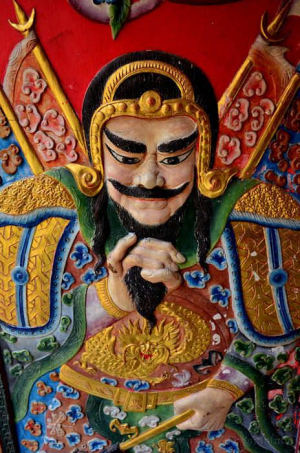
The Chinese make substantial use of color symbolism; throughout history colors have had specific associations including a color that was used for each dynasty's robes and emblems.
According to the theory of five elemental properties there are five primary colors: red, yellow, blue (which includes green), white and black. Traditionally colors have been vivid and brash, to brighten up the drab houses of the time. In ancient days the character 色 sè was also used as a word for conjugal sex as in Confucius's dictum ‘Eating and sex are given by nature’. Here is a brief summary:
Red is the color of joy and celebration and the lucky color. Red paper is often used for writing expressions of good wishes. White is the color of mourning and funerals. It represents purity. Blue/Green is the color of growth and vegetation and so life itself. Black is the color of illness, death and criminality. Yellow/Golden is the national color and the color of the emperor. Imperial building roofs were yellow to represent yin and earth, while walls were painted red to represent yang and heaven.
To this should be added later introductions to the spectrum: green and blue as separate colors and purple. Purple is an imperial color and also used in the robes of high officials. Brown was the Imperial color of the Song dynasty and represents the earth element, it has no single character in Chinese - it is just ‘dark yellow’. A modern name is 咖啡色 kā fēi sè ‘coffee colored’. Orange is a surprisingly late addition to English as it was named after the fruit and in Chinese there is still no word for it - the color is described as either red or yellow. In Buddhist symbolism red, blue and black are fierce colors while white and yellow denote mildness. Propitious gods are generally white and demons black.
Here are the individual colors that are noted for their symbolism in Chinese art:
Black 黑 hēi
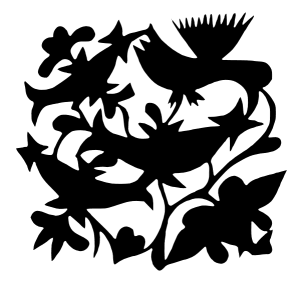
In the Feng Shui system black is associated with water. From the destruction cycle of elements black (water) extinguishes red (fire); and so the dynasty associated with ‘red’ should be followed with a ‘black’ dynasty. The first Qin Emperor therefore chose black as his emblematic color to extinguish the red of the preceding Zhou dynasty. The roof of the library in the Forbidden City was painted black rather than Imperial yellow to keep fire away because of the water association.
Black denotes darkness and death but also honor, so in Chinese opera a blackened face is used for grim but honorable characters. The character for black 黑 hēi originates from the process of producing soot which was then made into black ink. The character represents a blackened window collecting soot over a flame.
There a variety of other characters than refer to black in specific contexts: 玄 xuán sombre, mysterious; 黎 lí black hair; 缁 zī black silk and 黛 dài dark dye.
Blue 蓝 lán
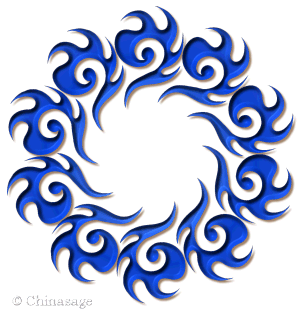
Generally the color blue has a negative connotation in China. Opera characters with blue make-up are usually ghosts or bad characters. Blue eyes, considered beautiful in the west, are very rare amongst Han Chinese. The wearing of blue flowers or ribbons in the hair is considered unlucky and many tombs were painted blue. However a bluebird is the messenger from the gods, principally associated with the Queen Mother of the West.
Pure blue is an expensive dye and for centuries a blueish-green was all that was available, this is called 青 qīng the character is used in the name of Qinghai province after the color of the lake water from which it takes its name. As in other cultures separate words for ‘blue’ and ‘green’ were not originally used, qing was used for both colors. Cobalt blue ➚ that gives the deep pure color to porcelain glazes only became available in the Yuan dynasty when it was imported from Persia.
Kuixing the god of examinations is painted with a blue face and, as he committed suicide, he is not a particularly lucky figure. Studying into the night was called to ‘study under the blue lamp’ and blue was the color associated with scholars. Blue was also used as the color for the sedan chairs for one grade of senior officials.
Green 绿 lù
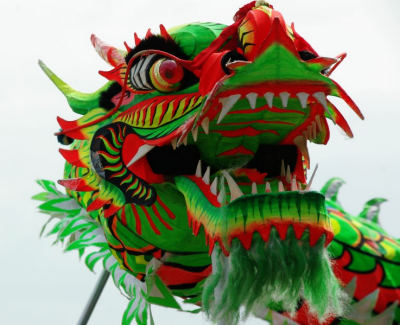
Green is the color of vegetation and so is the symbol of spring and promise of future harvest in China. It is generally a propitious color and also the color of the God of Literature's robes.
Green is the color associated with the element ‘wood’, the Ming dynasty and the lucky number 8. The character for green uses the radical for silk denoting the use of green as a dye. It has long been known as the complementary color to red in decorations and paintings. Originally the character 青 qīng was used for both the colors blue and green. 绿 lù: refers specifically to leaf-green rather than blue-green.
Purple 紫 zǐ
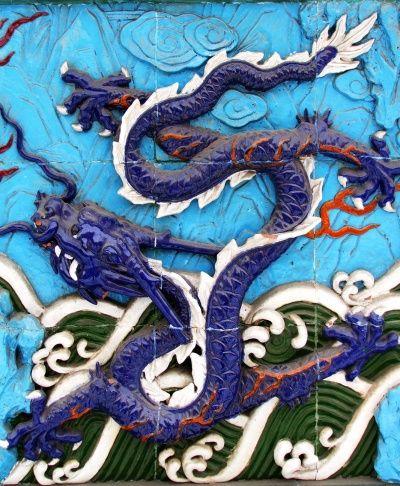
As in Rome, the color purple is associated with the Chinese Emperor because of its rarity and expense. Han purple ➚ is made from crushed Azurite and some Copper ore. The Imperial capital district was formally called the 紫禁城 Zijin Cheng the ‘Purple Forbidden City’ which matches the ‘Purple Forbidden Enclosure’ 紫微垣 in the stars around the North pole. It came into widespread use only at a late date and is not considered one of the five principal colors.
In Chinese opera a face is painted purple to represent an incorruptible, loyal mandarin. In color symbolism it represents grief and introspection.
Red 红 hóng
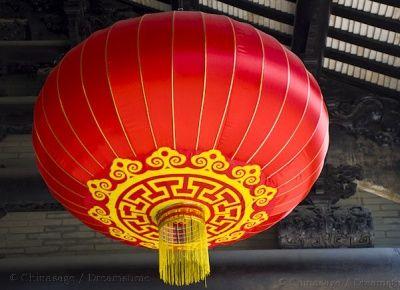
Red is the color of blood and so by association the color of life itself. In the Feng shui system of five elements, red is associated with south and summer. Red is the luckiest color and is widely seen at festivals and marriages to wish good luck and keep evil at bay. Charms written on red paper are used all over houses at Chinese New Year because according to legend the Nian monster is frightened away by anything red. Hóng 宏 sounds the same and means ‘great, magnificent’ so a red color bestows idea of wish for greatness in decorations. A red bat is a wish for abundant fortune.
Cinnabar gives the red color 丹 dān (often called 朱 zhū vermillion) for official seals and in itself was considered a potent elixir for long life. The pigment vermillion was reserved for the Emperor - he would write his own comments on documents in vermillion ink.
Scarlet or dark red has its own a separate character 绯 fēi which is similar to English ‘scarlet’ in meaning as it represents a blush of embarrassment.
Red was the dynastic color of the Chinese Zhou dynasty so many things had to be colored red during that period, a red raven was the emblem of the dynasty. A traditional marriage custom is for the newly weds to drink from cups connected with a red thread. The Boxers who formed a rebellion at the start of the 20th century wore red. The preponderance of red had a resurgence under Mao's communist era and it may well be that the ancient auspicious associations of red helped the communist cause. At that time there was a proposal to rename Beijing as Hongjing ‘red capital’. In opera a red painted face indicates divinity and heroism and is often used for Guandi the god of righteous action.
White 白 bái

White, which is really the absence of color rather than a true color, is associated with the direction west, and autumn in the theory of five elements. White, or more correctly, un-dyed cloth (specifically 素 sù) is worn for funerals and mourning in contrast to black in the west, it was therefore inappropriate to wear white at weddings. White was the dynastic color of the Shang dynasty. The white lotus is the main emblem for purity and virginity. It also represents simplicity as in 白话 bái huà which refers to the ordinary spoken language as opposed to the literary form. As white hair color comes with old age it can also depict wisdom. In Opera white make-up symbolizes treachery and a white flower in women's hair is considered unlucky.
There are other characters that represent white in specific contexts for example: 皑 ái snow and 皓 hào old white hair.
Yellow 黄 huáng
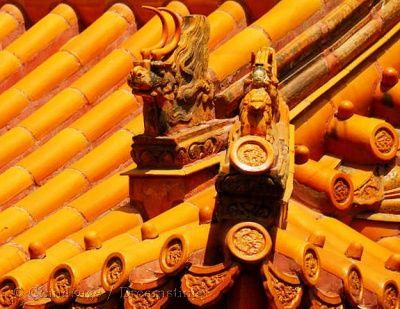
Yellow is a very auspicious color in China, it is probably best translated as ‘golden’ as that gives to a non-Chinese a better idea of its attributes. It is associated with the Earth element and ‘center’. The loess soils of northern China are ‘Yellow earth ’ 黄土 huáng tǔ and the Yellow River flows through this cradle of Chinese civilization. The Yellow Emperor was the mythical founder of China – indeed 皇 huáng ‘emperor’ sounds the same. Yellow is the color of Imperial robes and the roofs of Imperial buildings. Charms written on yellow paper were bought at temples to keep evil out of the home. The stars on the Chinese flag are all yellow. The deep orange-yellow of the Buddhist robe by contrast is called 大黄 dà huáng. All of this shows the importance of the color yellow in China.
The exception to all this positivity is pornography which is considered ‘yellow’ rather than ‘blue’ as it is in the west; this is possibly because this is the color of mud at the bottom of the swamp.